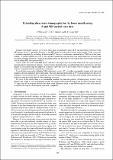| dc.contributor.author | Widiyantoro, S. | |
| dc.contributor.author | Kennett, B. L. N. | |
| dc.contributor.author | van der Hilst, R. D. | |
| dc.contributor.author | van der Hilst, Robert D | |
| dc.date.accessioned | 2016-06-23T15:54:00Z | |
| dc.date.available | 2016-06-23T15:54:00Z | |
| dc.date.issued | 2014-06 | |
| dc.date.submitted | 1998-08 | |
| dc.identifier.issn | 1880-5981 | |
| dc.identifier.uri | http://hdl.handle.net/1721.1/103293 | |
| dc.description.abstract | Seismic tomography using S wave travel times faces the difficulty imposed by the interference between S and SKS phases near 83° epicentral distance, as the SKS phase overtakes the S waves in the mantle. If the cross-over is avoided completely by excluding S data beyond 82° then no resolution is available below 2200 km in the lower mantle. A partial solution is to try to pick up the S phase beyond the cross-over which improves coverage and resolution in depth. However, a much larger improvement can be made by following the first arrival with S character and including SKS information with S.
Arrival times for both S and SKS phases and the event hypocentres have been taken from the reprocessing of data reported to international agencies. Each event has been relocated, including depth phase information, and later phases re-associated using the improved locations to provide a set of travel times whose variance is significantly reduced compared with the original data catalogues.
S travel-time tomography including SKS information out to 105°, provides tomographic images with improved rendition of heterogeneity in the lower mantle. The three-dimensional models of SV wavespeed relative to the ak135 reference velocity model show a significant increase in heterogeneity at the base of the mantle which matches the behaviour seen in results derived from waveform inversion.
For most of the mantle there is a considerable similarity between the patterns of heterogeneity in the S wave images and recent P wave tomographic results, but greater differences develop in the lowermost mantle. In the D″ region the SV wavespeed patterns also show some differences from recent SH wavespeed results which mostly correlate with regions of recognised structural complexity. | en_US |
| dc.publisher | Springer Berlin Heidelberg | en_US |
| dc.relation.isversionof | http://dx.doi.org/10.1186/BF03352194 | en_US |
| dc.rights | Creative Commons Attribution | en_US |
| dc.rights.uri | http://creativecommons.org/licenses/by/4.0/ | en_US |
| dc.source | Springer Berlin Heidelberg | en_US |
| dc.title | Extending shear-wave tomography for the lower mantle using S and SKS arrival-time data | en_US |
| dc.type | Article | en_US |
| dc.identifier.citation | Widiyantoro, S., B. L. N. Kennett, and R. D. van der Hilst. “Extending Shear-Wave Tomography for the Lower Mantle Using S and SKS Arrival-Time Data.” Earth Planet Sp 50, no. 11–12 (November 1998): 999–1012. | en_US |
| dc.contributor.department | Massachusetts Institute of Technology. Department of Earth, Atmospheric, and Planetary Sciences | en_US |
| dc.contributor.mitauthor | van der Hilst, Robert D. | en_US |
| dc.relation.journal | Earth, Planets and Space | en_US |
| dc.eprint.version | Final published version | en_US |
| dc.type.uri | http://purl.org/eprint/type/JournalArticle | en_US |
| eprint.status | http://purl.org/eprint/status/PeerReviewed | en_US |
| dc.date.updated | 2016-05-23T09:38:13Z | |
| dc.language.rfc3066 | en | |
| dc.rights.holder | The Society of Geomagnetism and Earth, Planetary and Space Sciences (SGEPSS); The Seismological Society of Japan; The Volcanological Society of Japan; The Geodetic Society of Japan; The Japanese Society for Planetary Sciences. | |
| dspace.orderedauthors | Widiyantoro, S.; Kennett, B. L. N.; van der Hilst, R. D. | en_US |
| dspace.embargo.terms | N | en_US |
| dc.identifier.orcid | https://orcid.org/0000-0003-1650-6818 | |
| mit.license | PUBLISHER_CC | en_US |
